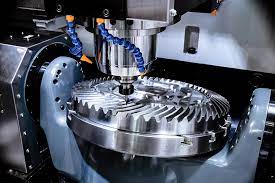CNC machining is a blend of science, technology, and craftsmanship. Mastering this powerful manufacturing method involves not only understanding the underlying principles and technology but also refining the artistry required to achieve exceptional results consistently. In this guide, we will introduce you to expert techniques that will help you unlock the full potential of CNC machining and create parts with perfect precision and surface finish.
Leveraging Advanced CNC Machining Techniques
Staying up-to-date with the latest CNC machining advancements can help you achieve even better results:
- High-Speed Machining (HSM): High-speed machining allows for faster material removal rates while maintaining excellent surface finishes. Implement HSM strategies to minimize cycle times and maximize productivity.
- 5-Axis Machining: 5-axis CNC machines offer greater flexibility and access to complex part geometries, reducing the need for multiple setups and improving accuracy. Consider investing in 5-axis technology to unlock new possibilities in custom CNC services.
- Cryogenic Machining: This innovative technique uses liquid nitrogen to cool the cutting zone, reducing heat generation, and extending tool life. Cryogenic machining is particularly useful for machining difficult-to-cut materials like titanium and superalloys.
Mastering Tool Selection and Toolpath Strategies
Choosing the right cutting tool and designing efficient toolpaths are essential for achieving optimal results. Keep the following tips in mind:
- Select the appropriate cutting tool geometry and material for your workpiece to maximize tool life and performance.
- Consider using specialized toolings, such as high-feed mills or trochoidal milling strategies, to reduce cutting forces and improve tool life.
- Leverage advanced CAM software features, like adaptive clearing and rest machining, to optimize tool paths and minimize machining time.
Fine-tuning Cutting Parameters
Optimizing cutting parameters, such as spindle speed, feed rate, and depth of cut, can significantly impact part quality and machining efficiency:
- Experiment with different combinations of cutting parameters to find the sweet spot for your material and tooling, balancing productivity and tool life.
- Utilize cutting data from tooling manufacturers and machining calculators to establish a starting point for parameter optimization.
- Monitor tool wear and adjust cutting parameters accordingly to maintain part quality and extend tool life.
Implementing In-Process Inspection and Adaptive Machining
Incorporating in-process inspection and adaptive machining techniques can help you achieve perfect results by compensating for tool wear, thermal expansion, and other variables:
- Use touch probes and on-machine measurement systems to verify part dimensions and adjust machining processes in real time.
- Implement adaptive machining strategies, such as cutter compensation and toolpath correction, to maintain tight tolerances and perfect surface finishes.
Maximizing Machine Stability and Rigidity
A stable and rigid machine setup is critical for achieving perfect results in CNC machining:
- Ensure your machine is well-maintained, with proper alignment, lubrication, and calibration.
- Select the most rigid work-holding solution for your part geometry, and invest in high-quality vises, fixtures, and clamps.
- Minimize tool overhang and use the shortest possible tool length to reduce vibrations and improve surface finish.
Mastering Surface Finishes and Post-Processing Techniques
The final appearance and functionality of your machined part are often determined by surface finishes and post-processing operations:
- Opt for finishing tool paths, such as constant scallop height or parallel finishing, to achieve a uniform surface finish.
- Utilize specialized cutting tools, like ball nose end mills or lollipop cutters, for complex surface geometries and hard-to-reach areas.
- Experiment with post-processing techniques, such as polishing, bead blasting, or anodizing, to enhance the appearance, corrosion resistance, and mechanical properties of your part.
By incorporating these expert techniques into your CNC machining workflow, you’ll be well on your way to achieving perfect results, time and time again. Embrace the art of CNC machining and enjoy the satisfaction of producing parts with unmatched precision and quality.
Embracing Automation and Industry 4.0
Integrating automation and Industry 4.0 technologies can further enhance your CNC machining capabilities:
- Robotic Loading and Unloading: Automate repetitive tasks, such as loading and unloading parts, to reduce manual labor, increase productivity, and minimize human error.
- Tool Management Systems: Implement tool management systems to monitor tool usage, predict tool wear, and schedule tool replacements automatically.
- Data Analytics and Machine Monitoring: Collect and analyze data from your CNC machines to identify inefficiencies, optimize processes, and predict maintenance needs.
Fostering a Culture of Continuous Improvement
Mastering CNC machining requires a commitment to continuous learning and improvement:
- Training and Education: Invest in ongoing education for yourself and your team to stay current with the latest trends, technologies, and best practices in CNC machining.
- Peer Collaboration: Engage with the CNC machining community through online forums, social media, and industry events to share knowledge, and experiences, and learn from other experts in the field.
- Benchmarking and Process Evaluation: Regularly assess your CNC machining processes and benchmark them against industry standards to identify areas for improvement and drive innovation.
By incorporating these additional strategies and techniques into your CNC machining practice, you’ll continue to refine your skills and achieve even greater levels of precision and perfection. Remember that the art of CNC machining is a lifelong journey, and with dedication, curiosity, and a commitment to continuous improvement, you’ll become a true master of this powerful manufacturing method.
Understanding and Minimizing CNC Machining Errors
Even the most skilled CNC machinists can encounter errors during the machining process. Identifying and addressing these errors can help you achieve even better results:
- Tool Deflection: Tool deflection occurs when cutting forces cause the tool to bend, affecting part accuracy and surface finish. To minimize tool deflection, use the shortest possible tool length, choose tools with larger shank diameters, and apply optimal cutting parameters.
- Thermal Expansion: Heat generated during the machining process can cause both the workpiece and machine components to expand, potentially leading to inaccuracies. Utilize proper cooling techniques, such as flood coolant or mist systems, and allow your workpiece to reach room temperature before measuring or performing finishing operations.
- Machine Vibration and Chatter: Vibration and chatter can negatively impact surface finish, tool life, and part accuracy. To reduce these issues, ensure your machine is properly maintained and aligned, use rigid work-holding solutions, and experiment with cutting parameters to find the most stable conditions.
Prioritizing Workplace Safety and Sustainability
As a CNC machinist, it’s essential to prioritize safety and sustainability in your operations:
- Safety: Implement safety procedures and guidelines to minimize the risk of accidents, including proper machine operation, tool handling, and personal protective equipment (PPE) use. Regularly inspect and maintain equipment to ensure safe working conditions.
- Sustainability: Consider the environmental impact of your CNC machining operations and adopt sustainable practices whenever possible. This may include recycling chips and coolant, using energy-efficient equipment, and optimizing processes to minimize material waste and energy consumption.
Expanding Your CNC Machining Capabilities
As you continue to master CNC machining, consider exploring new areas and expanding your capabilities:
- Additive Manufacturing: Combining CNC machining with additive manufacturing technologies, such as 3D printing, can open up new possibilities for creating complex parts and optimizing designs for both performance and manufacturability.
- Micromachining: Micromachining involves creating extremely small and precise features, often at the micron level. Developing expertise in micromachining can enable you to work on specialized projects, such as microfluidic devices or miniature components for electronics and medical devices.
- Hybrid Machining: Hybrid CNC machines combine multiple manufacturing processes, such as milling and laser cutting or additive manufacturing, into a single machine. By mastering hybrid machining, you can streamline your workflow and enhance your manufacturing capabilities.
Continuing to expand your skills and knowledge in CNC machining will ensure that you stay at the forefront of this dynamic field. Embrace new technologies, techniques, and challenges, and you’ll continue to refine your mastery of CNC machining, achieving even greater levels of precision and perfection in your work.
Investing in Quality Control and Inspection
Quality control and inspection are crucial aspects of CNC machining that ensure parts meet required specifications and tolerances:
- Measurement Tools: Invest in a range of high-quality measurement tools, such as calipers, micrometers, and height gauges, to accurately verify part dimensions and surface finishes.
- Coordinate Measuring Machines (CMM): Consider incorporating CMM technology into your inspection process. CMMs provide highly accurate and automated measurements of complex part geometries, helping you maintain tight tolerances and verify part conformity.
- First Article Inspection (FAI): Perform first article inspections to validate your machining process and ensure the first part meets all requirements before proceeding with production runs. This can help you identify and address potential issues early on, saving time and resources.
Building a Strong CNC Machining Network
Establishing connections with other CNC machinists, suppliers, and industry professionals can provide valuable resources and support as you continue to master CNC machining:
- Suppliers: Build relationships with reputable tooling, material, and equipment suppliers to ensure access to high-quality products and up-to-date information on new technologies.
- Machining Services: Partner with other CNC machine shops or specialized machining services to expand your capabilities and collaborate on complex projects that may require resources beyond your own.
- Industry Associations: Join industry associations and organizations to stay informed about the latest trends, regulations, and best practices in CNC machining. Participate in conferences, workshops, and webinars to expand your knowledge and network with peers.
Embracing a Problem-Solving Mindset
A key aspect of mastering CNC machining is adopting a problem-solving mindset that embraces challenges and encourages innovation:
- Troubleshooting: Develop strong troubleshooting skills to diagnose and resolve issues that arise during the machining process. This includes identifying the root cause of problems, such as tool breakage, poor surface finish, or dimensional inaccuracies, and implementing effective solutions.
- Innovative Thinking: Embrace innovative thinking to find new ways to optimize your CNC machining processes, create unique part geometries, and overcome obstacles. This may involve experimenting with unconventional tooling or techniques, modifying existing designs, or developing entirely new solutions.
By incorporating these strategies and adopting a problem-solving mindset, you’ll be well-equipped to tackle the diverse challenges that CNC machining presents. As you continue to refine your skills and expertise, you’ll unlock new opportunities for growth, innovation, and success in your CNC machining endeavors.
Conclusion
Mastering CNC machining is a lifelong journey that requires dedication, continuous learning, and a passion for precision and craftsmanship. By embracing the expert techniques and strategies outlined in this guide, you’ll be well on your way to achieving unrivaled precision and exceptional results in your CNC machining projects. Understanding the fundamentals and fine-tuning cutting parameters to incorporating advanced technologies and fostering a culture of continuous improvement, the path to mastery involves both the art and science of CNC machining. Remember to prioritize safety and sustainability, invest in quality control and inspection, and build a strong network within the industry to support your ongoing growth and success. As you continue to refine your skills, expand your capabilities, and adopt a problem-solving mindset, you’ll become a true master of CNC machining, creating parts with unmatched precision, quality, and innovation. Embrace the challenges and opportunities that CNC machining offers, and enjoy the satisfaction and accomplishment that come with perfecting your craft.








